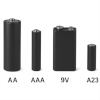Alkaline batteries - fun facts

The capacity of a battery expressed in mAh is a mandatory piece of information for rechargeable batteries, but not for disposable ones. This is because the actual capacity of such batteries heavily depends on testing conditions like the load current, temperature, the age of the battery, and the device type, leading to potentially differences of up to 50% in test results for the same battery. The European Committee for Electrotechnical Standardization (CENELEC) states that there is no single universal capacity value for primary (disposable) batteries that accurately reflects their performance, making the presentation of one capacity figure potentially misleading because the battery's runtime and reliability depend not only on mAh but also on voltage characteristics during discharge.
As for recharging alkaline batteries, despite the existence of chargers offering this option, experts strongly advise against it. These batteries, marked with symbols like LRXX, are designed for single use. Recharging them often results only in partial energy recovery and carries high risks, such as electrolyte leakage and permanent damage to the battery.
In summary: It is worth using alkaline batteries due to their high performance and reliability, but it should be remembered that the mAh capacity markings on disposable batteries are unreliable, and charging them can be dangerous.






